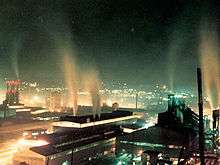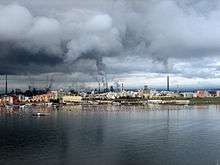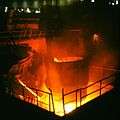Ilva (company)
Ilva S.p.A. was an Italian steel company that for much of the 20th century was Italy's largest steel producer and one of the largest in Europe. Ilva was established in 1905 in Genoa and existed through the decline of European steel manufacturing during the 1970s and 1980s until its final privatization in 1995. Ilva main assets, including giant Taranto steelworks, Europe's largest, were acquired by Gruppo Riva. In 2012 Taranto steel plant was at the centre of an environmental scandal that led to the arrest and conviction of some Riva family members and the transfer of the steelworks to ArcelorMittal.
 | |
| State-owned company | |
| Industry | Steel |
| Fate | Acquired by Gruppo Riva |
| Founded | 1905 |
| Defunct | 1995 |
| Headquarters | Genoa, Italy |
Key people | Oscar Sinigaglia, Agostino Rocca, Giovanni Gambardella (last CEO) |
| Products | Flat steel products, stainless steel, alloy steel |
| Revenue | $7.7 billion (1989)[1] |
| $487 million (1989)[1] | |
Number of employees | 48,500 (1989)[1] |
| Parent | ArcelorMittal |
| Website | italia |
History
Early history (1905-1934)
The company was founded in Genoa on 1 February 1905, its namesake being the Latin name for Elba island, seat of plentiful iron ore deposits that fueled the first blast furnaces built in Italy in the late 19th century.[2]
Ilva was born from the merger of the steel activities of Siderurgica di Savona group, of Acciaierie di Terni and of its subsidiary Ligure Metallurgica. The initial share capital of the limited company was 12 million Italian lire, that was increased to 20 million lire when Elba group joined shortly after. The new company, controlled by Genoese financers, was set up with the political and financial backing of the Italian state, in order to build the Bagnoli steel plant, as part of the 1904 law for the development of Naples, prepared by economist and later prime minister Francesco Saverio Nitti. During the First world war Ilva benefited from big state contracts, but the end of the war effort and the postwar recession, combined with the effects of the red scare of 1920-21, brought it close to bankruptcy and in 1922 Banca Commerciale Italiana assumed control of the company.[3]
From IRI to italsider (1934-1995)

Ilva continued to struggle during the 1920s, until the 1929 crash dealt a fatal blow to the company, that in 1934 was eventually acquired by IRI, the public holding company established in 1933 by the Fascist regime to rescue, restructure and finance banks and private companies that went bankrupt during the Great Depression. Ilva thus became part of Finsider, IRI's holding specializing in steel production (that controlled also Acciaierie di Cornigliano S.p.A. steelworks, known as SAIC, and many other smaller steel companies, among which Terni Acciai Speciali S.p.A. and Dalmine S.p.A.). After the Second world war, IRI president Oscar Sinigaglia used Marshall Plan funds to rebuild and modernize SAIC steelworks in Cornigliano and merged them with Ilva in 1961, creating a new company called Italsider.[3] The new company expanded rapidly in the 1960s. In 1965 giant Taranto integrated iron and steel complex became operational, occupying 5,000 workers and adding 10.5 million tons of capacity to Italsider.[4] However, by the early 1970s steel production in the EEC was suffering from overcapacity and foreign competition. Italsider made no exception, taking very heavy losses during steel crisis that hit all the Western economies in the late 1970s and especially in the 1980s. In 1984 Italsider sold SAIC to COGEA, a consortium of private steel companies dominated by Falck Group, that in turn resold it to Gruppo Riva in 1988.[5] In 1992 Italsider, in a last attempt to reduce overcapacity and losses, closed Bagnoli steelworks in Naples
Gruppo Riva ownership and environmental scandal at Taranto (1995-2012)

In 1995 the Italian state decided to get rid of loss-making Ilva and its subsidiaries. Gruppo Riva purchased the Taranto steel plant, the German-based multinational ThyssenKrupp took over Acciai Speciali Terni S.p.A. (AST); Dalmine S.p.A. (steel pipes and tubes) was sold to Tenaris; and other plants were ceded to Gruppo Lucchini.[6] Thus, Gruppo Riva came to own Taranto steelworks in southern Italy, Europe's largest steel plant.[7] During a 2012 inquiry, Taranto steel plant has been found to produce elevated emissions of dioxin, correlated to abnormally high cancer incidence in the area, bringing to the seizure of the plant by the Italian state.[8] According to the European Pollutant Emission Register, emissions of dioxin by Taranto steel plant accounted for 30.6 per cent of all emissions in Italy in 2002,[9] and much more according to an inquiry by PeaceLink NGO.[10]
(2012-2019) - From the commissioners to ArcelorMittal
In 2012, an investigation for environmental crimes and pollution led the Taranto prosecutor to order the seizure without the right to use the plants in the furnace area. To safeguard the establishment and employment, the Italian government has initiated the company commissioner procedure and launched an international tender for a assignment of the same. Since January 2015, the company has been under extraordinary administration pursuant to the Marzano Law.
By March 2017, ArcelorMittal was leading a consortium bidding for Ilva.[11][12] The ArcelorMittal consortium was selected as the preferred bidder over a different consortium led by JSW Steel after it was able to pledge a production increase and guarantee employment levels. The final decision was waiting on Italy’s ministry of economic development.[12]
On 5 June 2017, ArcelorMittal won approval to purchase Ilva for €1.8 billion. The buyers were the AM Investco consortium, which beyond ArcelorMittal included Marcegaglia and Banca Intesa Sanpaolo. In its bid, AM Investco also pledged to make investments into Ilva of €2.4 billion until 2023.[13] ILVA is part of ArcelorMittal Group as of 1 November 2018.
On 5 November 2019 ArcelorMittal announced its intention to withdraw from the transfer agreement, returning it to Ilva, in extraordinary administration, within 30 days[14]. Procedures to shut down the plant were started, then interrupted under legal and political pressure[15].
2020 - The return to the commissioners management
In 2020, ILVA returns to the commissioners management, under the protection of the penal shield, implementing all the modernization procedures and environmental sustainability of the Taranto plant.[16][17][18] [19]
See also
References
- The European Union and national industrial policy. Routledge. 1996. pp. 72–73. ISBN 0-203-43880-9.
- "Ilva". treccani.it. Treccani. Retrieved 5 November 2019.
- Tolaini, Roberto. "Ilva-Italsider. Storia" (PDF). www.storiaindustria.it. Centro online storia e cultura dell'industria. Retrieved 26 April 2020.
- King, Russell (2015). The industrial geography of Italy. Rutledge. ISBN 978-1138854406.
- Meny, Yves; Wright, Vincent (1987). The Politics of Steel: Western Europe and the Steel Industry in the Crisis Years (1974-84). Berlin: Walter De Gruyter. p. 462. ISBN 0899251943.
- "Conflicts over restructuring in steel sector". Eurofound. Retrieved 26 March 2020.
- "The travails of "ex-Ilva", Europe's largest steel plant". The Economist. 27 February 2020. Retrieved 27 March 2020.
- "Europe's largest steelworks : Jobs v health". The Economist. 28 September 2012. Retrieved 26 April 2020.
- Riva, Gigi (30 March 2007). "La Puglia dei veleni". L'Epsresso. Retrieved 27 March 2020.
- "Peacelink" (PDF). Retrieved 31 January 2009.
- Pooler, Michael; Politi, James (5 March 2017). "Bidding race to win Europe's biggest steel plant heats up". Financial Times. United Kingdom. Retrieved 8 June 2017.
- Pooler, Michael; Politi, James (26 May 2017). "ArcelorMittal-led group leads race to buy Ilva steel plant". Financial Times. United Kingdom. Retrieved 8 June 2017.
- Pooler, Michael (6 June 2017). "ArcelorMittal wins race to buy Italian steel business Ilva". Financial Times. United Kingdom. Retrieved 8 June 2017.
- "AM InvestCo Italy sends withdrawal and termination notice from the lease and purchase agreement for Ilva business". corporate.arcelormittal.com. Retrieved 12 December 2019.
- "A.Mittal has suspended furnace switchoff at Taranto steelworks - union - English". ANSA.it. 18 November 2019. Retrieved 12 December 2019.
- "Ilva, interviene la procura di Milano e i commissari fanno ricorso d'urgenza". milanofinanza.it. 16 November 2019. Retrieved 16 November 2019.
- "Ex-Ilva, i commissari denunciano Arcelor Mittal". ilsole24ore.com. ilsole24ore.com. Retrieved 16 November 2019.
- "Ex Ilva, ArcelorMittal spegne tutti gli altiforni: chiusura definitiva a gennaio". ilsole24ore.com. ilsole24ore.com. 16 November 2019. Retrieved 16 November 2019.
- "Ex Ilva, Conte: non consentiremo la chiusura, ArcelorMittal pagherà i danni". ilsole24ore.com. ilsole24ore.com. 15 November 2019. Retrieved 17 November 2019.
